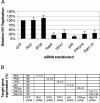Rab9 GTPase is required for replication of human immunodeficiency virus type 1, filoviruses, and measles virus
- PMID: 16140752
- PMCID: PMC1212642
- DOI: 10.1128/JVI.79.18.11742-11751.2005
Rab9 GTPase is required for replication of human immunodeficiency virus type 1, filoviruses, and measles virus
Abstract
Rab proteins and their effectors facilitate vesicular transport by tethering donor vesicles to their respective target membranes. By using gene trap insertional mutagenesis, we identified Rab9, which mediates late-endosome-to-trans-Golgi-network trafficking, among several candidate host genes whose disruption allowed the survival of Marburg virus-infected cells, suggesting that Rab9 is utilized in Marburg replication. Although Rab9 has not been implicated in human immunodeficiency virus (HIV) replication, previous reports suggested that the late endosome is an initiation site for HIV assembly and that TIP47-dependent trafficking out of the late endosome to the trans-Golgi network facilitates the sorting of HIV Env into virions budding at the plasma membrane. We examined the role of Rab9 in the life cycles of HIV and several unrelated viruses, using small interfering RNA (siRNA) to silence Rab9 expression before viral infection. Silencing Rab9 expression dramatically inhibited HIV replication, as did silencing the host genes encoding TIP47, p40, and PIKfyve, which also facilitate late-endosome-to-trans-Golgi vesicular transport. In addition, silencing studies revealed that HIV replication was dependent on the expression of Rab11A, which mediates trans-Golgi-to-plasma-membrane transport, and that increased HIV Gag was sequestered in a CD63+ endocytic compartment in a cell line stably expressing Rab9 siRNA. Replication of the enveloped Ebola, Marburg, and measles viruses was inhibited with Rab9 siRNA, although the non-enveloped reovirus was insensitive to Rab9 silencing. These results suggest that Rab9 is an important cellular target for inhibiting diverse viruses and help to define a late-endosome-to-plasma-membrane vesicular transport pathway important in viral assembly.
Figures






Similar articles
-
Short hairpin RNA-mediated inhibition of measles virus replication in vitro.Can J Microbiol. 2010 Jan;56(1):77-80. doi: 10.1139/w09-103. Can J Microbiol. 2010. PMID: 20130697
-
Visualization of Rab9-mediated vesicle transport from endosomes to the trans-Golgi in living cells.J Cell Biol. 2002 Feb 4;156(3):511-8. doi: 10.1083/jcb.200109030. Epub 2002 Feb 4. J Cell Biol. 2002. PMID: 11827983 Free PMC article.
-
Inhibition of filovirus replication by the zinc finger antiviral protein.J Virol. 2007 Mar;81(5):2391-400. doi: 10.1128/JVI.01601-06. Epub 2006 Dec 20. J Virol. 2007. PMID: 17182693 Free PMC article.
-
Virus and host interactions critical for filoviral RNA synthesis as therapeutic targets.Antiviral Res. 2019 Feb;162:90-100. doi: 10.1016/j.antiviral.2018.12.006. Epub 2018 Dec 11. Antiviral Res. 2019. PMID: 30550800 Free PMC article. Review.
-
Human immunodeficiency virus type-1 gag and host vesicular trafficking pathways.Curr Top Microbiol Immunol. 2009;339:67-84. doi: 10.1007/978-3-642-02175-6_4. Curr Top Microbiol Immunol. 2009. PMID: 20012524 Review.
Cited by
-
Identification of an epithelial cell receptor responsible for Clostridium difficile TcdB-induced cytotoxicity.Proc Natl Acad Sci U S A. 2015 Jun 2;112(22):7073-8. doi: 10.1073/pnas.1500791112. Epub 2015 May 18. Proc Natl Acad Sci U S A. 2015. PMID: 26038560 Free PMC article.
-
Virus-producing cells determine the host protein profiles of HIV-1 virion cores.Retrovirology. 2012 Aug 13;9:65. doi: 10.1186/1742-4690-9-65. Retrovirology. 2012. PMID: 22889230 Free PMC article.
-
HIV Assembly and Budding: Ca(2+) Signaling and Non-ESCRT Proteins Set the Stage.Mol Biol Int. 2012;2012:851670. doi: 10.1155/2012/851670. Epub 2012 Jun 12. Mol Biol Int. 2012. PMID: 22761998 Free PMC article.
-
RNAi therapy for HIV infection: principles and practicalities.BioDrugs. 2007;21(1):17-22. doi: 10.2165/00063030-200721010-00003. BioDrugs. 2007. PMID: 17263586 Free PMC article. Review.
-
Suppression of PmRab7 by dsRNA inhibits WSSV or YHV infection in shrimp.Mar Biotechnol (NY). 2008 Jul-Aug;10(4):374-81. doi: 10.1007/s10126-007-9073-6. Epub 2008 Jan 24. Mar Biotechnol (NY). 2008. PMID: 18214608
References
-
- Basyuk, E., T. Galli, M. Mougel, J. M. Blanchard, M. Sitbon, and E. Bertrand. 2003. Retroviral genomic RNAs are transported to the plasma membrane by endosomal vesicles. Dev. Cell 5:161-174. - PubMed
Publication types
MeSH terms
Substances
LinkOut - more resources
Full Text Sources
Other Literature Sources
Miscellaneous

